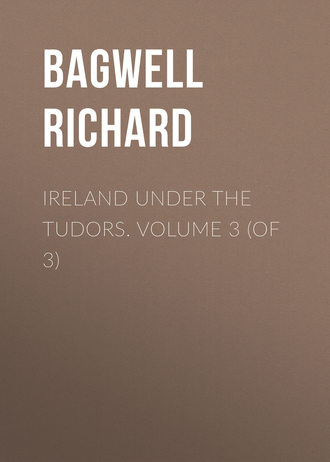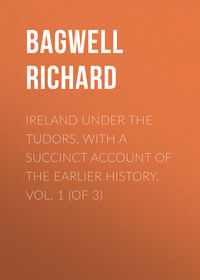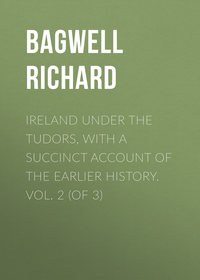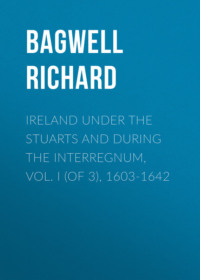 полная версия
полная версияIreland under the Tudors. Volume 3 (of 3)
287
Ormonde to Cecil, Sept. 15. In writing to the same, on Aug. 24, Ormonde admits the reduced list of twenty-four officers killed and one taken prisoner, 855 men killed and 363 wounded. To these must be added the missing, and there were certainly several hundred deserters. Other English estimates of loss are considerably higher. Camden says 1,500 men were killed.
288
Four Masters, 1598. Sir C. Clifford to the Lords Justices, Sept. 7; to Cecil, Oct. 30; Lady Clifford’s declaration, Oct. 31.
289
Lords Justices and Council to the Privy Council, Nov. 23 and 27, 1598. Sir R. Bingham to the Lords Justices (from Naas) Nov. 27. There is a MS. dialogue among the Irish S.P. for 1598, which purports to be the ocular testimony of the writer, Thomas Wilson, and which is dedicated to Essex. The interlocutors are Peregryn and Silvyn – the names of Spenser’s two sons – and the dialogue, which unfolds the state of things in King’s County from harvest 1597 to All Saints’ Day 1598, is very much in the style of that between Irenæus and Eudoxus. Is Thomas Wilson a stalking-horse for Edmund Spenser?
290
Four Masters, 1598; O’Sullivan, tom. iii. lib. v. cap. 2; Discourse by William Weever (prisoner with the Munster rebels) Sept. 29 to Oct. 10. Fenton to Cecil, April 20, for the Tower story.
291
Ormonde to James Fitzthomas, Oct. 8, 1598; James ‘Desmonde’ to Ormonde, Oct. 12.
292
Ormonde to the Queen, Oct. 12, 1598; Chief Justice Saxey’s account, October.
293
List of castles abandoned without resistance in Ormonde’s letter to the Queen, Oct. 21, 1598; Oliver Stephenson to Norris, Oct. 16; Henry Smyth’s State of Munster ‘as I did see and hear it,’ Oct. 30. An anonymous paper of October gives some details of Raleigh’s settlement at Tallow. See also James Sarsfield, mayor of Cork, to the Privy Council, Oct. 21.
294
Arthur Hyde to the Privy Council, Oct. 28, 1598; Captain F. Barkley to the Lords Justices, Nov. 3.
295
Sir T. Norris to the Privy Council and to Cecil, Oct. 23, 1598; W. Weever’s discourse, Oct.; Chief Justice Saxey’s account, Oct.; the Queen to Ormonde and the Lords Justices, Dec. 1, and to Norris, Dec. 3; Moryson, book i. chap. i.; O’Sullivan, tom. iii. lib. v. caps. 1-5; Four Masters, 1598. Dunqueen is close to Slea Head, the westernmost point of Kerry.
296
Ormonde to the Privy Council, Nov. 5, 1598; Edward Gough and George Sherlock to Sir N. Walshe, Nov. 16. Gough and Walshe held Cistercian lands at Innislonagh and Glandore; Sherlock had those of the Canons Regular at Cahir; but none of the three bore Protestant names.
297
Ormonde to the Privy Council, Nov. 5, 1598; to the Queen, Jan. 19, 1599; the Queen to Ormonde and the Lords Justices, Dec. 1, 1598, in Carew. Bingham’s appointment as Marshal was announced on Aug. 31, only seventeen days after Bagenal’s death. He reached Ireland in October, and died at Dublin, Jan. 19. A memorial by Cecil, dated Nov. 4, 1598 (in Carew, p. 523), has the words ‘Clifford betrayed, Bingham lightly condemned.’ Bingham’s Irish patent is dated Oct. 13, and the Queen informed the Lords Justices that she had specially chosen him, that he was to draw pay and allowances from the day of Bagenal’s death, and that he was to have all the privileges that had ever attached to the office. Morrin’s Patent Rolls, 40 Eliz. 57 and 58.
298
Four Masters, 1598 and 1599. The Queen to Sir T. Norris, Dec. 3, 1598, in Carew.
299
Four Masters, 1599. For Con O’Neill see Carew, March and April, Nos. 299-301; Journal of Sir T. Norris, from March 27 to April 4; Justice Golde to Essex, April 4; Essex to Privy Council, April 29. Lord Roche had a private quarrel with the Sugane Earl.
300
Parallel between Essex and Buckingham in Reliquiæ Wottonianæ.
301
Reliquiæ Wottonianæ; Camden; Essex to the Queen in Devereux’s Earls of Essex, i. 493. The letter quoted in the text is the best proof that Camden’s story is substantially true. See also Spedding’s Life of Bacon, ii. 91, 103. For Spanish popular notions on Philip III. see Carew, Aug. 23, 1602. Beaumont, the French ambassador in 1602, says the Queen told him, in a broken voice, that she had warned Essex long since ‘qu’il se contestast de prendre plaisir de lui déplaire à toutes occasions, et de mepriser sa personne insolemment comme il faisait, et qu’il se gardast bien de toucher à son sceptre.’ – Von Raumer, Letter 60.
302
Spedding, ii. 124-126; Essex to John Harrington in Park’s edition of Nugæ Antiquæ, i. 246.
303
Bacon’s advice to Essex immediately before his going to Ireland, Spedding, ii. 129; Essex to Southampton, Jan. 1, 1599, printed by Abbott; Bacon’s Apology, first printed in 1604.
304
The letter of advice is in Spedding, ii. 129; Apology concerning the Earl of Essex; Essex to Southampton in Abbott’s Bacon and Essex, chap. ix. Jan. 1, 1599. Essex wrote to the Queen, just before starting, as follows: ‘From a mind delighting in sorrow, from spirits wasted with passion, from a heart torn with care, grief, and travail, from a man that hateth himself and all things also that keepeth him alive, what service can your Majesty expect? since my service past deserves no more than banishment and proscription into the cursedst of all other countries.’ The letter ends with some verses in praise of a contemplative life, and Essex signs himself ‘your Majesty’s exiled servant.’ —MS. Harl. 35, p. 338.
305
The progress of the negotiations may be traced in Chamberlain’s Letters (Camden Society). Essex to Southampton, Jan. 1, 1599; and Charles Blount (afterwards Lord Mountjoy) to Essex, Jan. 3, both in Abbott, chap. ix.
Full little knowest thou, that has not tried,What hell it is in suing long to bide;To lose good days that might be better spentTo waste long nights in pensive discontent;To speed to-day, to be put back to-morrow, &c.’ —Spenser.306
Devereux, ii. 16-24; Four Masters; Prayer for the good success of Her Majesty’s forces in Ireland (black letter, London, 1599).
Were now the general of our gracious empress(As in good time he may), from Ireland coming,Bringing rebellion broached on his sword,How many would the peaceful city quit,To welcome him? —Henry V. Act 5.307
Chamberlain’s Letters, 1599. Robert Markham to John Harrington in Nugæ Antiquæ, i. 239; Fenton to Cecil, May 7; Fynes Moryson’s Itinerary, part i. book i. ch. i. At Hatfield there are a great many letters asking Essex to employ the writers or their friends in Ireland. Most of these anticipate triumph. William Harborn on Feb. 3 asks for nothing, but presents the Earl with an Italian history of the world in four volumes, ‘to attend your honour, if they be permitted, in this your pretended Irish enterprise, at times vacant to recreate your most heroical mind.’ The Queen’s instructions speak of a ‘royal army, paid, furnished, and provided in other sorts than any king of this land hath done before.’ Its nominal strength was raised to 20,000, but they were never really under arms at once.
308
The Commission, dated March 12, is in Morrin’s Patent Rolls, ii. 520. The instructions, dated March 27, are fully abstracted by Devereux, and in Carew.
309
Chichester to Cecil, March 17, 1599, MS. Hatfield. Account of Sir Arthur Chichester by Sir Faithful Fortescue in Lord Clermont’s privately printed Life of Sir John Fortescue, &c.
310
Report on state of Ireland April 1599, in Carew, and further particulars in Dymmok’s Treatise of Ireland (ed. Butler, Irish Arch. Society, 1843). Dymmok’s account of the Leinster and Munster journey is, with slight omissions, word for word (but better spelt) Harrington’s journal from May 10 to July 3, after which it is continued from other sources. (Nugæ Antiquæ, i. 268-292.) There is an independent journal in Carew from May 21 to July 1. The opinion of the Irish Council is printed by Devereux, i. 24. Essex to the Privy Council, April 29. Sir H. Wotton to Ed. Reynolds, April 19, MS. Hatfield, where it is noted that Sir H. Wallop died within an hour of the Lord Lieutenant’s arrival.
311
Nugæ Antiquæ, i. 269-275; Four Masters; O’Sullivan Bere, tom. iii. lib. v. cap. 9. O’Donovan cannot exactly identify the ‘transitus plumarum,’ and the name is forgotten in the district. Harrington places it between Croshy Duff hill, which is two and a half miles from Maryborough on the Timahoe road, and Cashel, which is four miles from Maryborough on the Ballyroan road. Captain Lee, in Desiderata Curiosa Hibernica, i. 114, suggests that Tyrone would willingly settle all his differences with Bagenal (whom he very wrongly accuses of cowardice) by a duel. Tyrone was the last man in the world to do such an act of folly, but Lee exposes his own character.
312
The Lord President, Ormonde, and other councillors ‘hath persuaded me for a few days to look into his government.’ – Essex to the Privy Council, May 21, 1599, MS. Hatfield. The few days were a full month. Nugæ Antiquæ, i. 275-278; Journal of occurrents in Carew, under June 22. The battery was planted on May 28, and all was over by the 31st. ‘The castle of Cahir, very considerable, built upon a rock, and seated in an island in the midst of the Suir, was lately rendered to me. It cost the Earl of Essex, as I am informed, about eight weeks’ siege with his army and artillery. It is now yours without the loss of one man.’ – Cromwell to Bradshaw, March 5, 1649. Thus history is falsified by flattery and local vanity. There is a picture-plan of the siege in Pacata Hibernia.
313
Journal of occurrents in Carew, under June 22; Nugæ Antiquæ, i. 278-280. The Journal, the Four Masters, and O’Sullivan Bere, tom. iii. lib. v. cap. 6, all agree that Norris died of a wound in the head. ‘Kilthilia’ may be Kilteely near Hospital, whither the Journal says the wounded man was first carried. He died in his own house at Mallow.
314
Nugæ Antiquæ and Journal ut sup. Essex left Askeaton on the 8th, and arrived at Waterford on June 21. The Queen to Lord and Lady Norris, Sept. 6, in S.P. Domestic, and Rowland Whyte to Sir R. Sidney, Sept. 8, in Sidney Papers.
315
The contemporary accounts are collected in National MSS. of Ireland, part iv. i. app. xiv. Atherton’s is the most minute. There is also a field-sketch made by Captain Montague. The Irish were not numerically stronger than Harrington’s force. Loftus, who died at Wicklow for want of a skilful surgeon, was the archbishop’s son.
316
Journal in Carew, under July 1; Nugæ Antiquæ, i. 254, 259, and 286-292; Dymmok’s Treatise. Essex left Waterford June 22, and reached Dublin July 2.
317
Essex to the Privy Council, July 11; Devereux, ii. 50-52; Fynes Moryson, part ii. lib. i. cap. i.; Nugæ Antiquæ, i. 292; Reliquiæ Wottonianæ.
318
Privy Council to Essex, June 10; Essex to the Privy Council, July 11; the Queen to Essex, July 19.
319
Essex to the Privy Council, May 21, MS. Hatfield; Cecil to Sir H. Neville, May 23, in Winwood’s Memorials; Chamberlain’s Letters, June 10; Essex to the Queen, June 25, in Moryson; the Queen to Essex, July 19.
320
Dymmok’s Treatise, p. 43; Nugæ Antiquæ, i. 255; the Queen to Essex, July 19 and Aug. 10. Harrington’s comrade was Gerald, fourteenth Earl of Kildare. The ‘sergeant-major’ was either Captain Richard Cuny or Captain George Flower.
321
The Queen to the Lord Lieutenant and Council, Aug. 10 in Carew; Chamberlain’s Letters, Aug. 23.
322
Dymmok’s Treatise, p. 44; Nugæ Antiquæ, i. 255-257 and 264-268; Four Masters. Harrington was present, and Dymmok’s account is from those who were. O’Sullivan Bere says the English lost 1,400 men, but Harrington says Clifford’s whole force hardly amounted to that number. O’Donnell, though not far off, took no actual part in the fight. H. Cuffe to E. Reynolds, Aug. 11, MS. Hatfield, written when the bad news was quite fresh.
323
Four Masters; MacDermot’s letter is in Dymmok; Essex’s instructions for Dillon, Savage, and Dunkellin in Carew, Aug. 10. Dymmok gives Aug. 15 as the date of Clifford’s death, but it must have been a week earlier.
324
Essex to the Queen, soon after Aug. 15, in Devereux, ii. 56, and two other letters at p. 67. The officers’ declaration is at p. 55, where the names of the signatories are given. They fairly justify the Queen’s stricture in her letter of Sept. 14.
325
Dymmok’s Treatise; Journal in Carew, No. 315. The two accounts substantially agree. It was the hereditary privilege of O’Hagan to inaugurate O’Neill.
326
Journal in Carew and Dymmok ut sup. Moryson and Camden closely agree. The chronology is as follows: Essex leaves Dublin Aug. 28; musters at Castle Kieran, Aug. 31; between Robinstown and Newcastle, Sept. 2; Ardee, Sept. 3; Mills of Louth, Sept. 4; O’Hagan’s first overtures, Sept. 5; the meeting at Bellaclinthe, Sept. 7; cessation concluded, Sept. 8; Essex goes to Drogheda, Sept. 9. See also Shirley’s Monaghan, p. 104. There is a story told somewhere that Tyrone spoke much of religion, and that Essex answered, ‘Go to, thou carest as much for religion as my horse.’ The original articles of cessation, dated Sept. 8 and signed Hugh Tyrone, are at Hatfield.
327
Essex to the Queen, Aug. 30, from Ardbraccan; the Queen to Essex. Sept. 14 and 17 – all printed by Devereux. On March 27, Essex had licence at his own request ‘to return to her Majesty’s presence at such times as he shall find cause,’ but this was revoked by her letter of July 30. Sir H. Wotton to E. Reynolds, April 19, MS. Hatfield.
328
Harrington to Justice Carey in Nugæ Antiquæ, i. 247. Park gives April as the date of this letter, but this is disproved by internal evidence, and it certainly belongs to October. See also ib. pp. 260 and 340. Warren’s own account of his ‘second journey to the Earl of Tyrone,’ is dated Oct. 20. The first lines of the 45th canto of Harrington’s translation of Orlando are: —
Look how much higher Fortune doth erectThe climbing wight on her unstable wheel,So much the higher may a man expectTo see his head where late he saw his heel, &c.329
Sir Christopher St. Lawrence, according to Camden, offered his services to kill both the peer and the secretary.
330
Letters from Rowland Whyte to Sir Robert Sidney in Sidney Papers, ii. 117, 127, from Sept. 19 to Oct. 2; Essex’s Relation, written by him during his imprisonment.
331
The letter to Essex is of Nov. 22, and with seventeen others belonging to the last three months of 1599, is printed by Mr. Gilbert in App. 16 to National Manuscripts, Ireland, part iv. 1. In a letter of Nov. 6, to the Lords Justices, Lord Lieutenant (Ormonde), and Council, the Queen approves of the slaughter by Ormonde ‘in revenge of that that brake the cessation in Wexford… do not irritate nor oppress any such as have submitted … in respect of any private unkindness of your own.’
332
‘Tyrone’s Propositions, 1599’ are in Winwood’s Memorials, i. 118, immediately after Cecil’s letter of Oct. 8 to Neville, and are reprinted by Spedding and Abbott. The letter does not mention any enclosure. In Bacon and Essex, pp. 134-148, Dr. Abbott endeavours, not very successfully, I think, to show that the document is entirely unworthy of credit. It is, however, not called ‘Essex’s propositions,’ but ‘Tyrone’s,’ and I have shown that the most outrageous part of it was regarded by the Queen as a serious proposal. Essex should have broken off the conference at the mere mention of such a thing. Sidney would have done so, or Norris, or Mountjoy. The Queen’s letters to Fenton and to the Lords Justices, &c., are of Nov. 5 and 6.
333
The Queen to the Lords Justices, &c. Nov. 6; Tyrone to Warren, Dec. 25; to the King of Spain, Dec. 31; to Lord Barry and others, Feb. 1600, in Carew. On Feb. 13, 1600, the Vicar Apostolic Hogan told Lord Barry he had ‘received an excommunication from the Pope against all those that doth not join in this Catholic action.’ James Archer, S.J., in a letter of Aug. 10, 1598, printed in Hibernia Ignatiana, p. 39, informs Aquaviva of ‘frequentes Catholicorum victorias, unde fit ut hæretici ex multis locis migrare cogantur.’ For Henry Fitzimon, S.J., the priest of whose imprisonment Tyrone complained, see his Life by Rev. E. Hogan, S.J., p. 209. ‘I never went to Tyrone,’ Warren wrote to Cecil, on Dec. 24, 1599, ‘but I was forced to bribe his Friars and Jesuits.’
334
Mountjoy to the Queen, printed in Goodman’s James I. (ed. Brewer) ii. 23; Letters of Rowland Whyte to Sir Robert Sidney, Oct. 31, 1599, to Jan. 12, 1600, in Sidney Papers.
335
Rowland Whyte to Sir R. Sidney, Nov. 29, 1599, to Feb. 9, 1600, in Sidney Papers; Fynes Moryson, book ii. chap. i.
336
Letters in Carew, Dec. 31, 1599, and Feb. 13, 23, and 26, 1600; Tyrone to Barry with the answer, in Pacata Hibernia, Feb, 26, 1600; Four Masters, 1599 and 1600.
337
Docwra’s Narration; Pacata Hibernia, lib. i. cap. 1.
338
Pacata Hibernia, lib. i. caps. 2 and 14. The Four Masters say St. Leger’s encounter with Maguire was premeditated, but the English account is here to be preferred. Compare O’Sullivan Bere, tom. iii. lib. v. cap. 12. Lady St. Leger had been previously married to Davells and Mackworth, and was thus by violence left a widow for the third time.
339
The Queen to Mountjoy, March 10, in Carew; Carew and Thomond to the Privy Council, April 18, ib.
340
Carew and Thomond to the Privy Council, April 18, in Carew and Pacata Hibernia. See also the Catholic accounts of the Four Masters and of O’Sullivan and Peter Lombard. All the documents are collected in a memoir by the Rev. James Graves, in the Irish Archæological Journal, N.S. vol. iii. pp. 388 sqq. There are two contemporary drawings, one of which is reproduced in Pacata Hibernia and the other in Facsimiles of Irish MSS., part iv. 1. I have endeavoured to harmonise the various accounts.
341
Ormonde to the Queen, June 16; F. Stafford to Cecil, June 18; Mountjoy to Cecil, July 4 – all in Mr. Graves’s memoir cited above. And see his further note in Irish Arch. Journal, N.S. vol. v. p. 333. On Aug. 21, Redmond Keating submitted to Mountjoy, on condition to deliver the Earl’s pledges remaining in his hands; see in Carew under Aug. 26, 1600. The Kellies and Lalors did the same.
342
Fenton to Cecil, April 12; Carew and Thomond to the Privy Council, April 18; Tyrone to O’More April 22/May 2; to Ormonde April 29/May 9 and May 26/June 6; to Lady Ormonde May 25/June 5; Ormonde to the Queen June 16 – all these are in the memoir cited. Elizabeth, Lady Ormonde, was the Earl’s second wife, and daughter of John, second Lord Sheffield. In Eugene Magrath’s Irish panegyric on her husband (circ. 1580) every laudatory epithet is lavished on the ‘amiable, lovely, &c. countess.’ See this curious poem in Irish Arch. Journal (Kilkenny), i. p. 470.
343
Note of Captain Flower’s journey, April 1; Joshua Aylmer to Cecil, April 21; Sir Henry Power to the Privy Council, April 30; Carew to Cecil, May 2; Florence MacCarthy to Cecil, May 6; Pacata Hibernia, lib. i. cap. 5. Cecil’s letter to Essex, April 1599, St. Leger’s and Power’s to Cecil, Dec. 10, and Lord Barry’s to Cecil, Feb. 12, 1600, are printed in Florence MacCarthy’s Life, chap. 9.
344
Docwra’s Narration, edited by O’Donovan for the Celtic Society’s Miscellany. The cockle-shell island was probably one of the ‘kitchen-middens’ which are common on the Irish coast.
345
Docwra’s Narration; Fynes Moryson’s Itinerary, part ii. lib. i. cap. 2; Four Masters, 1600. Mountjoy left Dublin on May 6, and remained out till the end of the month. See also his letter to Carew of July 1 in Carew. ‘The garrison of Derry,’ say the annalists, ‘were seized with disease on account of the narrowness of the place and the heat of the summer. Great numbers died of this sickness.’
346
Carew to Cecil, May 6 and Aug. 17; Pacata Hibernia, lib. i. chaps. v. and vi.
347
Pacata Hibernia, lib. i. ch. vii.; Four Masters. June 18 is the proper date of this capture; the annalists wrongly say that it was in January.
348
This raid was at midsummer. —Four Masters and Pacata Hibernia, lib. i. ch. viii.
349
Pacata Hibernia, lib. i. cap. 18. The date of the murder was Oct. 24.
350
Declaration of Sir Charles Danvers in the correspondence of James VI. with Cecil (Camden Society). The evidence of Cuffe, Blount, and Southampton in the same collection bears this out. Southampton saw James’s answer to Mountjoy’s first letter. It contained nothing but compliments, allowing of his reservations, and referring him for the matter to the bearer (Lee), who delivered unto him that the King would think of it, and put himself in readiness to take any good occasion.’ There is a letter to Essex at Hatfield dated from the Court at Nonsuch, Aug. 18, 1599, in which Thomas Wenman warns the Earl that he had been slandered to the King of Scots as being opposed to his succession, that James would work all craft for his destruction, and that he should be careful who he had about him.
351
Declaration of Danvers ut sup.; Henry Cuffe to the Council, ib., and his Examination, March 2, 1601 (printed by Spedding); Confession of Southampton, ut sup.
352
Fynes Moryson’s Itinerary, part ii. book i. cap. 2; Four Masters, 1600.
353
Mountjoy to Carew, Aug. 12, in Carew; Moryson, ut sup.; Four Masters, 1600. This raid was during the last days of July and the first of August.
354
Moryson, ut sup.; Journal, 11-26, under latter date in Carew; Mountjoy to Carew, Sept. 4, ib.




